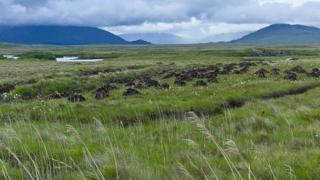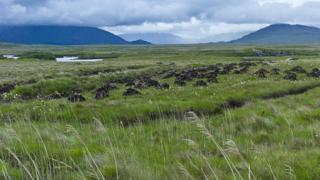Climate change: Peatlands ‘turning into carbon sources’
Scientists call for urgent action to prevent peatlands drying out and releasing vast stores of carbon. …

 Image copyright Getty Images
Image copyright Getty Images Peatlands are a natural carbon sink, absorbing CO2 from the atmosphere and burying it in the soil.
In Europe alone, they lock up about five times more carbon than forests.
But according to a new study, the continent’s peatlands are in such a dry and fragile state, they could go into reverse, releasing rather than absorbing carbon.
Scientists say it is more important than ever that we restore and safeguard these boggy landscapes.
Researchers examined 31 peatlands across England, Ireland, Scandinavia and continental Europe to assess changes during the last 2,000 years.
The study, published in Nature Geoscience, found that most peatlands had become drier during the period 1800-2000 than they had been for the last 600 years.
- 40% were drier than they had been for 1,000 years
- 24% were drier than they had been for 2,000 years.
Dr Maarten Blaauw from Queen’s University Belfast said peatlands “have been a great help to our planet” – they suck carbon out of the atmosphere and store it, which helps to mitigate climate change.
This study, however, shows that “the drying of our bogs appears to have changed this process and the peatlands could now actually be turning into carbon sources – instead of absorbing carbon actually starting to emit it – clearly this is not good news for our planet”.
Dr Graeme Swindles from the University of Leeds, who led the study, said it is more important than ever that we safeguard peatlands with effective management and active restoration.
“The combined pressure of climate change and human impacts may push these vitally important carbon storing ecosystems into becoming a global source of carbon emissions.”
What are peatlands?
Peatlands are a type of wetland found in almost every country on Earth, from blanket bogs in the UK to swamp forests in Southeast Asia.
The term “peatlands” refers to the peat soil and the wetland habitat around it.
Peat forms over the course of millions of years as waterlogged conditions slow the process of plant decomposition.
Why are peatlands important in climate change?
Natural peatlands across the world store more carbon dioxide (CO2) than all other vegetation types in the world combined.
Large amounts of carbon, extracted from the atmosphere through photosynthesis, represent a global carbon store.
Countries are encouraged to include peatland restoration in their commitments to global international agreements on climate change, as this can help reduce emissions.
What damages peatlands?
Climate change, peat extraction, drainage, burning and conversion to farmland have all exacted a toll on peatlands.
About 15% of the world’s peatlands – covering less than 0.4% of the global land surface – have been drained, releasing greenhouse gases into the air, according to the International Union for Conservation of Nature – IUCN.
Follow Helen onTwitter.


